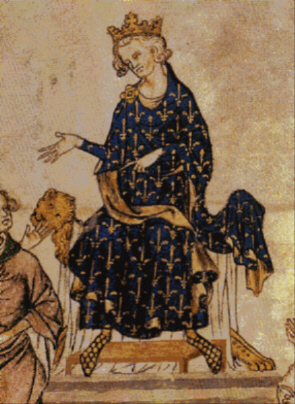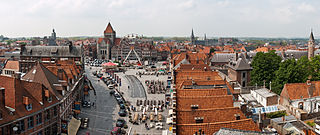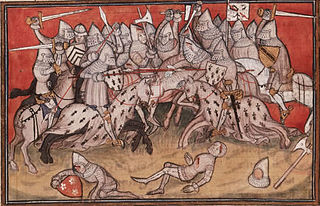
Philip VI, called the Fortunate, the Catholic and of Valois, was the first king of France from the House of Valois, reigning from 1328 until his death in 1350. Philip's reign was dominated by the consequences of a succession dispute. When King Charles IV of France died in 1328, his nearest male relative was his sororal nephew, Edward III of England, but the French nobility preferred Charles's paternal cousin, Philip of Valois.

Tournai or Tournay is a city and municipality of Wallonia located in the Province of Hainaut, Belgium. It lies 89 km (55 mi) by road southwest of the centre of Brussels on the river Scheldt, and is part of Eurometropolis Lille–Kortrijk–Tournai, In 2022, the municipality of Tournai had an estimated population of 68,518 people.

Jacob van Artevelde, sometimes written in English as James van Artvelde, also known as The Wise Man and the Brewer of Ghent, was a Flemish statesman and political leader.

The War of the Breton Succession was a conflict between the Counts of Blois and the Montforts of Brittany for control of the Sovereign Duchy of Brittany, then a fief of the Kingdom of France. It was fought between 1341 and 12 April 1365. It is also known as the War of the Two Jeannes due to the involvement of two rival duchesses of that name.

A Distant Mirror: The Calamitous 14th Century is a narrative history book by the American historian Barbara Tuchman, first published by Alfred A. Knopf in 1978. It won a 1980 U.S. National Book Award in History.

The first phase of the Hundred Years' War between England and France lasted from 1337 to 1360. It is sometimes referred to as the Edwardian War because it was initiated by King Edward III of England, who claimed the French throne in defiance of King Philip VI of France. The dynastic conflict was caused by disputes over the French feudal sovereignty over Aquitaine and the English claims over the French royal title. The Kingdom of England and its allies dominated this phase of the war, and Edward's sovereignty over Aquitaine was confirmed in the Treaty of Brétigny (1360), although he renounced his claim to the French throne.

Sir Robert Knolles or Knollys was an English knight of the Hundred Years' War, who, operating with the tacit support of the crown, succeeded in taking the only two major French cities, other than Calais and Poitiers, to fall to Edward III. His methods, however, earned him infamy as a freebooter and a ravager: the ruined gables of burned buildings came to be known as "Knollys' mitres".

The Battle of Roosebeke took place on 27 November 1382 on the Goudberg between a Flemish army under Philip van Artevelde and a French army under Louis II of Flanders who had called upon the help of the French king Charles VI after he had suffered a defeat during the Battle of Beverhoutsveld. The Flemish army was defeated, Philip van Artevelde was slain and his corpse was put on display.

Le Quesnoy is a commune and small town in the east of the Nord department of northern France. It was part of the historical province of French Hainaut. It is known for its fortifications, dating from the 16th, 17th and 18th centuries. It had a significant shoemaking industry before the late 1940s, followed by a chemical factory and dairy, giving way to its weekly market, tourism, local commuting to elsewhere such as Valenciennes and local shops.
Tournai in Wallonia, Belgium, has been sieged multiple times, including:

The Battle of Saint-Omer, fought on 26 July 1340, was a major engagement in the early stages of the Hundred Years' War, during Edward III's 1340 summer campaign against France launched from Flanders. The campaign was initiated in the aftermath of the English naval victory at the Battle of Sluys but was far less successful than Edward had hoped. At Saint-Omer, the heavily-outnumbered French men-at-arms, tasked with defending the city and awaiting reinforcements, unexpectedly defeated the Anglo-Flemish forces on their own. The allies suffered heavy losses and the French captured their camp intact, taking many warhorses, draft animals and carts, all the tents, huge quantities of supplies and most of the Flemish standards. Edward's campaign of 1340 had begun badly. On the bright side, the loss of several thousand men was bearable, as the survivors, which included most of the precious English longbowmen, eventually rejoined him at Tournai. The defeat had serious strategic consequences. It exposed southern Flanders to the wrath of Philip VI and enabled the French to concentrate their forces against the main army of the coalition in the siege of Tournai.

The Battle of Calais took place in 1350 when an English force defeated an unsuspecting French army which was attempting to take the city. Despite a truce being in effect the French commander Geoffrey de Charny had planned to take the city by subterfuge, and bribed Amerigo of Pavia, an Italian officer of the city garrison, to open a gate for them. The English king, Edward III, became aware of the plot and personally led his household knights and the Calais garrison in a surprise counter-attack. The French were routed by this smaller force, with significant losses and all their leaders captured or killed.

Louis de Sancerre was a Marshal of France and Constable of France during the Hundred Years' War.
The Truce of Espléchin (1340) was a truce between the English and French crowns during the early phases of the Hundred Years' War.
The Truce of Calais was a truce agreed by King Edward III of England and King Philip VI of France on 28 September 1347, which was mediated by emissaries of Pope Clement VI. The Hundred Years' War had broken out in 1337 and in 1346 Edward had landed with an army in northern France. After inflicting a heavy defeat on Philip and a French army at the Battle of Crécy the English besieged Calais, which fell after 11 months. Both countries were financially and militarily exhausted and two cardinals acting for Pope Clement were able to broker a truce in a series of negotiations outside Calais. This was signed on 28 September to run until 7 July 1348.
The Thiérache campaign, also known as the chevauchée of Edward III of 1339 was the march from Valenciennes, Hainault across Cambrésis, Picardy and Thiérache in northern France by an English army with Flemish, Hainault and Holy Roman Empire allies. It began on 20 September 1339, resulting in the siege of Cambrai and ended with the withdrawal of the English forces on 24 October, 1339, into Brabant. The English army was led by King Edward III, and the French by King Philip VI. It was a campaign during the Hundred Years' War.
The Tournaisis campaign of 1340, also known as the Tournai Campaign was a military campaign of King Edward III of England during the Hundred Years War. The English army was supported by Flemish, Hainault, Brabant and Holy Roman Empire forces. The campaign resulted in the defeat of an Anglo-Flemish force, carrying out a small scale chevauchée in the County of Artois, at the Battle of Saint-Omer, an unsuccessful siege of Tournai and ended with meeting of the English and French armies at Bouvines without battle. The campaign ended with the Truce of Espléchin and the withdrawal of the English led forces. The English army was led by King Edward III, and the French by King Philip VI of France.
The Treaty of Guînes was a draft settlement to end the Hundred Years' War, negotiated between England and France and signed at Guînes on 6 April 1354. The war had broken out in 1337 and was further aggravated in 1340 when the English king, Edward III, claimed the French throne. The war went badly for France: the French army was heavily defeated at the Battle of Crécy, and the French town of Calais was besieged and captured. With both sides exhausted, a truce was agreed that, despite being only fitfully observed, was repeatedly renewed.

The Revolt of Ghent (1379-1385) was an uprising by the city of Ghent against the count of Flanders and the king of France. Under the leadership of successively Jan Hyoens, Philip van Artevelde and Frans Ackerman, Ghent rebelled against Count Louis II of Flanders, Duke Philip the Bold of Burgundy and King Charles VI of France. It was an expression of the growing power of the Third Estate and of economic ties with England that had been strained by the Hundred Years' War. After six years of war, Ghent submitted to the ducal authority while avoiding further punishment. The dream of an autonomous city-state failed, and the era of royal centralization continued.

English offensives in 1345–1347, during the Hundred Years' War, resulted in repeated defeats of the French, the loss or devastation of much French territory and the capture by the English of the port of Calais. The war had broken out in 1337 and flared up in 1340 when the king of England, Edward III, laid claim to the French crown and campaigned in northern France. There was then a lull in the major hostilities, although much small-scale fighting continued.















